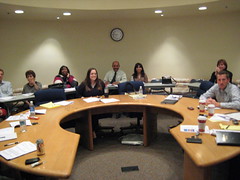No! This Isn’t Marketing!
E-mail Marketing is Not Dead: The Problem with the Social Media Bubble
There is a social media bubble. That is not to deny the growing importance of social channels in an integrated digital marketing strategy, but there are more and more voices decrying email as dead and only social networks, like Twitter and Facebook, as relevant. Why send an email, when you can tweet, they ask?
That not only misunderstands communication but is sure to ensure that their target audience misses their message.
E-mail is more relevant than ever, to reach key audiences. In addition, email has among the best ROI. Click through rates of email are among the highest — more than banner ads or video.
In 2010, over 107 trillion emails were sent — 294 billion per day. There were over 244 million new email users. 25% of which were corporate accounts.
Over 93% of web surfers subscribe to permission-based email, according to eMarketer. “Best practices for email marketing can be summarized in one sentence,” said David Hallerman, eMarketer principal analyst and author of the new report, “10 Best Practices for Email Marketing.” “Get accurate and detailed data from people who want to hear from you, then automate the numerous steps involved in sending them relevant messages.”
E-mail is also adapting and changing. These are concerns that marketers need to be aware of.
- More and more email is being read on mobile devices
- Email is increasingly becoming social as well, with content being shared online and links from articles being shared
“Not only does email usage remain a prime activity among internet users of all ages, it allows marketers to contact their target audience with timing and personalized details that social sites cannot match,” said Hallerman. “And the rise of mobile usage helps marketers reach their customers via email more than before, since many people use those devices to check email much more frequently than they might have in the past.”
Modern B2B Marketing: Creating Content that Sells
I received the following tips from Marketo, and think that they are worth reading for any business owner:
1. It is not promotional – promotional materials will neither excite nor inspire, both critical components of content marketing.
2. It is relevant – generic materials that are not highly relevant to a reader will not result in increased success. When writing content you must make sure it will be useful to the reader, regardless of whether it supports your company message.
3. It closes a gap – content marketing should answer a business question or problem. An added benefit of this useful information is its ability to be used in lead nurturing.
4. It is written well – poorly written thought leadership may not only provide poor results, but may also hurt the company’s reputation. Take time to ensure content is presented in a thoughtful manner and is free of errors.
5. It is relevant to your company – if the content you create does not support business objectives in any way, it is a waste of resources to produce. Keep business goals in mind when creating content.
6. It gives proof – since you write to support a business goal, your content may seem biased. Make sure that content you create gives proof either through quotes and testimonials or through actual metrics and statistics.
Gary Vaynerchuk: There is a Social Media Bubble
Gary Vaynerchuk has been a social media superstar. Certainly no Luddite, he’s used social media — and most important useful content and real expertise — to real business success, both for his wine business and personal businesses. I first discovered Gary Vaynerchuk three or four years ago, when he was in the early days of Wine Library TV and reviewed some Israeli wine for the first time.
Yet, Gary has said that there is a social media bubble. 99.5% of those who call themselves social media gurus (a terminology I’ve long rejected) are “clowns.”
On a recent TechCrunch TV, Gary Vaynerchuk said: “we are going to live through a devastating social media bubble.”
According to Gary, 99.5% of “social media gurus” (A term I would get insulted if anyone calls me that) don’t know how to define real business value. It’s not about “likes” or “fans” but rather about business value. This doesn’t happen at once. It’s not viral. It’s hard work – Gary is known for being online at all hours and answering emails at 3 in the morning.
Social media performs business functions: it’s not a function in itself.

Social media is a tool, like a telephone. He’s repeating a message that I’ve advised clients for years and longed believed: There is a Social Media Bubble.
Social media is a tool to create business value. It’s a tool to show appreciation to your customers, help them with customer service, and provide real business roles.
Are you hoping for the magic? Or are you focused on real, long-term business strategy.
The Need for Integrated Marketing: It’s Not Just Social Media
“If only we went viral” and “If only we had a Facebook page and an Internet guru who knew how to make our RSS feed than we could get on the front page of TechCrunch” is something that is commonly heard.
The promise of social media was, to some, the magic promise of viral marketing.
It’s a false promise.
The fundamentals still matter.
Marketing is not about viral or social media – rather it’s about developing the proper strategy to meet your business goals.
What are you trying to get and what is the pathway to get there?
- Brand Awareness?
- Revenue Growth?
- New Sales?
- Thought Leadership?
- Repeat Business?
- Saved Customers and Recovery of Customers?
- Introduce A New Program?
- Donations?
Each goal has a different tactic to meet that goal.

Social media is not the answer, it’s a channel. One of my favorite strategic frameworks, Forrester’s POST Analysis, explicitly states that you pick the People (Audience), Objectives, and Strategy before choosing what technology to implement this with.
Before determining the tactic, you need to develop the strategy that maps the strategy and tactics to your goal. This, of course, requires knowledge of integrated marketing: branding/positioning, public relations, marketing, web development, SEO, and more. Yes, with the growing importance of digital platforms, technological literacy is a must for any marketing strategist, but it is not the goal – rather the tool to get it.
Jono Bacon, the Community Manager of Ubuntu, a popular Linux distribution, has a good framework for how to map strategy with tactics in his book The Art of Community:
OBJECTIVE:
GOAL:
SUCCESS CRITERIA:
- Item
- Item
IMPLEMENTATION PLAN:
- Item
- Item
OWNER:
GOAL:
SUCCESS CRITERIA:
- Item
- Item
IMPLEMENTATION PLAN:
- Item
- Item
OWNER:
Marketing: It’s Not Just a Guessing Game
Frequently, in marketing meetings and client meetings, it’s assumed that everyone has an equal opinion and equal knowledge.
Because I use Facebook, that means that I can do social media marketing.
Because I’ve sent emails before, that means I know e-mail marketing.
I’ve read the newspaper, so I know public relations.
While it’s important to listen to all sides of the story, it’s also important to be based on professional standards and best practices.
What about:
- Branding and positioning
- Legal requirements and regulation, such as CAN-SPAM, regulating email marketing in the US, or Israeli legislation on email marketing
- Standards of e-mail marketing bounce rates and click rates
- Knowledge of lead generation and the sales funnel
- Cultural knowledge and nuances of your target markets
- Technical knowledge (HTML, Web Development, SEO)
We also understand that – like any other profession – marketing isn’t magic and viral isn’t a strategy. Rather, there is a process to build momentum, gain traction, and gain results. But starting with industry best practices, we can develop and implement the best roadmap to achieve your business results.
In today’s rapidly changing world, there is a significant role for experimentation and it’s important to listen to a variety of perspectives in order to maintain agile.
But experimentation is not a substitute for guessing.
As marketers, we have extensive experience and knowledge in what moves human behavior: qualitative and quantitative. That experience is the starting point for successful strategic implementation.
Marketing isn’t a guessing game. It’s not simply having an opinion. The fact that I have an opinion about baseball doesn’t make me a hall-of-fame pitcher – or even a member of the minor leagues. Self-diagnosis doesn’t make you a doctor.
It’s a profession, that we’ve invested hundreds of hours in research, education, and implementation. It’s only by bringing our background knowledge to the table that we can help your business expand.
The Viral Myth – Viral is not a Marketing Strategy
Frequently many companies look to a new strategy to promote themselves: going viral.
They either make a funny video or hire a social media manager with the goal to go ‘viral.’ If that tactic is not combined with an integrated marketing strategy, they are likely to fail.
Viral is not a marketing strategy.
Despite claims that social media democratizes media and communication, a recent study shows that your message still the greatest chance of being spread when expressed by a small number of elite influencers…. whether it’s Robert Scoble, Om Malik, an industry analyst or the New York Times. According to research by Yahoo!, roughly 50% of tweets consumed are generated by just 20,000 elite users.
In February, no one had heard of Rebecca Black or knew that on Friday everyone was looking forward to the weekend. Yet the 13-year-old’s video went unnoticed on YouTube for over a month. It only “went viral” after it was noticed by an influencer, comedian Michael Nelson, and a link on the Comedy Central’s Tosh.0 website. Then, as other influencers started noticing, Black’s video started gaining traction and now has over 97 million views and being the most disliked video on YouTube with almost 2 million dislikes. 15 years ago, America’s Funniest Home Videos never got that much exposure. Bob Saget must be jealous.
Of course, today the barriers of entry are much lower. It cost just $2,000 for Black’s family to make that video and another $2,000 to secure the rights. It’s far easier to get noticed today than it ever was before. But the field of people attempting to ‘go viral’ is also increasing.
This is why a holistic marketing approach, based on a solid business strategy, and connected by an integrated matrix of marketing touch points – public relations, advertising, email, SEO, MARCOM, and web development … in which some of your material developed are distributed and engaged with via social channels – is more important now than ever.
Because if you hope that ‘going viral’ will just happen disconnected from a holistic marketing strategy, keep hoping. Unless it’s Friday.
This post is crossposted on The Cline Group
Is there such a thing as Agile Marketing?
Recently, coworker, a software developer in an Agile software development shop, asked me if there was such a thing as Agile Marketing.
I had recently seen a webinar on the topic, listened to the Agile marketing podcast, but I wasn’t familiar with the term. The more I learned about it, the more I realized that the marketing I had learned was Agile. No, it didn’t have stand up meetings (they were usually gchats, instant messenger programs like AIM or Skype), kanban boards, and I wasn’t unit testing my HTML or PHP. But it did follow the principles that Agile project and development methodologies were designed for.
I first learned marketing on no budget, as a high schooler, who wanted to promote a cause. So, I started with a goal, designed a logo with the free Paint Shop Pro, and started to hand code HTML with a site on GeoCities and opened up an email list – long before the days of Yahoo or Google Groups. There were no wireframes. I was the web and graphic designer. I started doing rapid web prototyping by default – mostly because my coding skills were better than my graphic design skills.
So what is Agile marketing?
Agile marketing includes:
- technology-driven development
- sales and marketing automation
- flexible planning and sprints
No, it’s not about kanban or scrum or even XP and unit testing and TDD (but it usually does include web development.)
Since that’s how I started and had been online since 1991, it took me over a decade to realize that’s not how everyone worked… Wasn’t all marketing digital and technology based? Hasn’t this been the platform for the past 15+ years, at least?
I didn’t know that most marketers were scared to touch a line of code, resulting in delays for basic tasks and web content management instead of data driven and technologically integrated tools that measured business goals, allowing for resources to be dedicated based on their results. Instead, most people worked in a waterfall model, with wireframes delivered to developers to chop their Photoshop images, instead of rapid web prototyping.
Today’s digital tools, including marketing automation, web content management systems, CRM system (including Social CRM), and digital analytics tools provide the immediate feedback that’s important in Agile management and allow for marketing managers to make quick decisions, based on actual feedback from stakeholders.
Of course it’s not about old vs new. With the enhanced need for rapid response, the marketing fundamentals, such as clear branding and positioning, and messaging and message development are even more important when feedback loops and sprints are in play. In fact, in specialties like crisis communications or public relations-which have always demands instant response – these Agile principles are also baked into the industries’ best practices.
So yes, Agile isn’t just for software development. It’s time for Marketing to go Agile as well.
The problem with ‘social’ media
I hate the word social media. I hate the concept ‘social’ media. I’ve consistently refused to incorporate the word ‘social’ in my job titles.

I’m not a social media strategist. I’m a strategist. On this, I disagree with analysts like Altimeter’s Jeremiah Owyang.
I also don’t say that I do social media marketing. I don’t. I do marketing and today, media is social. (Today? When I was 15, half my lifetime ago, I started a nonprofit as a website, which I handcoded in HTML, and an email listserv).
OK, maybe I do social media.
… And telephone media.
… And print media.
… And radio media.
… And mobile media
… And spoken media.
… And email. And tradeshows.
 Ok. I’ll be honest. I’ve never (yet) created a trade show booth (but I’ve reached mass audiences and niche audiences without it). I’ve also never worked with a printer to create direct mail (which is probably good since printed snail mail volume is declining (no wonder, since it’s called ‘snail’ mail)). Is it that I’m really an online marketing strategist?
Ok. I’ll be honest. I’ve never (yet) created a trade show booth (but I’ve reached mass audiences and niche audiences without it). I’ve also never worked with a printer to create direct mail (which is probably good since printed snail mail volume is declining (no wonder, since it’s called ‘snail’ mail)). Is it that I’m really an online marketing strategist?
How does marketing to a trade group in LinkedIn or Meetup differ from doing it over the telephone or via the postal service and in person?
How is social media different from online media, in general?
The platform isn’t the most important thing. First choose your goal and objective, and then choose the platform.
The only ones talking about social are the ones not being social. If you’re singularly focused on the magical, wondrous world of ‘social media’ I promise it’s going to disappoint you. On the other hand, if you can use the appropriate tool for the appropriate time (both online and offline), I promise things will be much better.
My point is, with over 2 billion people online, including most of the developed world, marketers just need to be where their target audience is. Much of the time, it doesn’t matter (at least to digital natives like me that learned to use a computer at the same time that we learned how to use a telephone or write a letter). Do you care that I’m writing this post on my cellphone and not on paper? I didn’t think so.
The point is: for digital natives (the oldest of whom are now managers in their 30s… Don’t remind me) – equally comfortable online as off – differentiating media as social makes no sense.
So please, don’t say social media to me.
Viral is not a strategy
Viral is not a strategy and social media is not cost-free.






